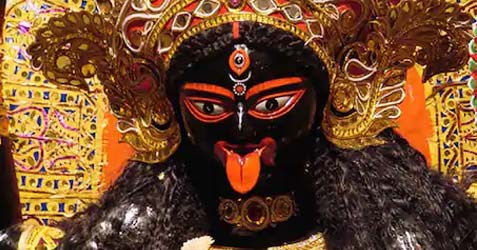
Goddess Kali enjoys a significant position in the Indian culture and Kali Puja is considered to be the perfect way of commemorating the Goddess. Kali Puja is performed to ask the Goddess Kali for sufficient strength to fight the evil forces and the enemies.
Kali Puja is primarily a Bengali festival, held in accordance to the lunar calendar around the first week of November. The Goddess Kali is worshipped at night on one night during this festival. Kali Puja is light-up night for Kolkata, corresponding to the North Indian festival of Diwali (pronounced Dipabali in Bengali). This is also a night of fireworks, with local youth burning sparklers and crackers throughout the night. Kolkata had to pass legislature a few years back to ban fireworks which break the 65 decibel sound limit, as ambient noise levels were going up to 90 decibels or more in parts of the city.
The national festival of the Bengalis, The Durga Puja ends with a somber tone. But soon, this melancholy slowly disappears with the arrival of Lakshmi Puja in between to finally the tri-festival of the Bengalis - Kali Puja, Diwali and last but not the least the 'Bhai Phota' or 'Bhai Dooj'. Kali Puja coincides with Diwali, the festivals of lights. Every households clean their houses and light up candles all over their houses. Children and adults set off firecrackers all night. No one sleeps on that night.
In Kolkata and the suburbs, Kali Puja is celebrated with equal pomp and grandeur. Always the images are not fiery looking ubiquitously. In many family Pujas, the sacred form of Goddess Kali is being worshipped as a practice. One cannot forget the extraordinary song penned by the famous poet hailing from Halishahar, Ramprasad Sen who developed a pure human relationship with his hymns. It is believed that Goddess Kali used to appear before him as his daughter. One remembers Rani Rashmoni had established the idol of Goddess Kali at Dakshineswar and had appointed Gadadhar alias Sri Sri Ramkrishna Paramahansa (known worldwide through Swami Vivekananda, his disciple's mission) as Her priest. It was this image of Goddess Kali of Dakshineswar which Swami Vivekananda found awakened and was transcended in another world after coming across the living deity.
Maa Kali is the fearful and ferocious form of the mother goddess Durga. She assumed the form of a powerful goddess and became popular with the composition of the Devi Mahatmya, a text of the 5th - 6th century AD. Here she is depicted as having born from the brow of Goddess Durga during one of her battles with the evil forces. As the legend goes, in the battle, Kali was so much involved in the killing spree that she got carried away and began destroying everything in sight. To stop her, Lord Shiva threw himself under her feet. Shocked at this sight, Kali stuck out her tongue in astonishment, and put an end to her homicidal rampage. Hence the common image of Kali shows her in her melee mood, standing with one foot on Shiva's chest, with her enormous tongue stuck out. Kali is often portrayed with her tongue hanging out and her mouth dripping blood. This is said to signify the force that gives impetus to all activities.
